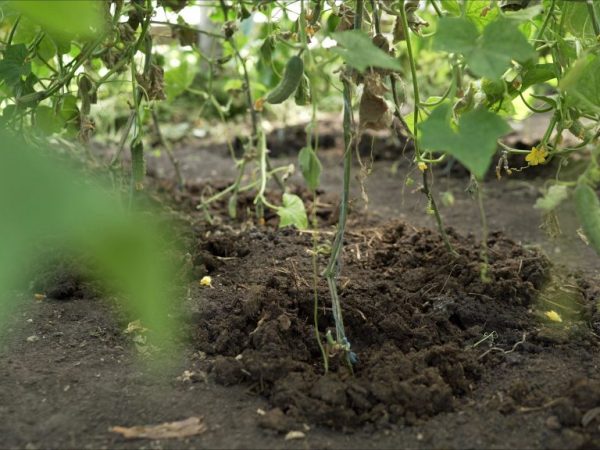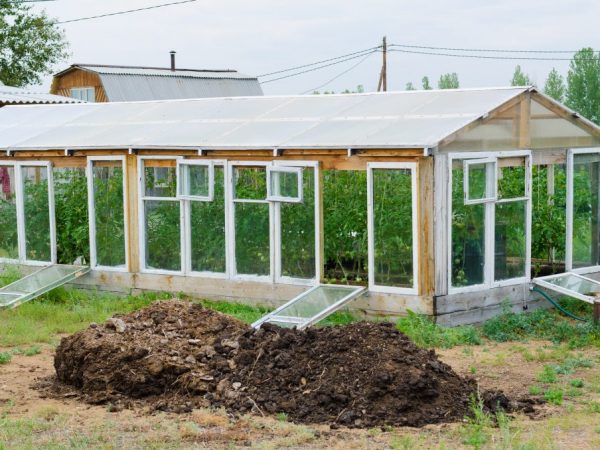Rules for feeding cucumbers with fresh manure
For the rapid growth of cucumbers and other crops, it is necessary to fertilize the soil: good nutrition will protect the root system of the plant from diseases. Feeding cucumbers with manure is carried out in the fall before harvesting and in the spring after planting seedlings.

Rules for feeding cucumbers with fresh manure
This valuable organic fertilizer contains nutrients that improve the fruitfulness of the crop. With the help of a natural additive, the quality of the soil is improved: the replenishment promotes the reproduction of microflora and the restoration of the correct balance of mineral substances in the soil.
The benefits of feeding
Fresh manure collected from domestic animals or fermented on the ground is used to feed the cucumbers. Economical additives do not harm the soil and are absolutely safe for crops. The composition of manure includes such useful substances:
- nitrogen;
- potassium;
- phosphorus;
- trace elements.
With the help of natural ingredients, the amount of salt in the soil decreases and its acidity decreases - in such conditions, the root system grows faster: the active growth of the bush affects the quality of the harvested crop. In enriched ground soil, the roots of cucumbers absorb less radioactive and toxic substances.
Fertilization during the period of active growth, flowering and fruiting of the bush ensures the growth of healthy fruits, which are useful to eat raw or pickled. The amount of a useful supplement for feeding is normalized (to maintain the correct acidity of the soil).
The natural substance improves the throughput of mineral supplements, as a result - the root system absorbs useful mineral supplements faster. An excess of land is harmful to all varieties of cucumbers: leaves wither, weeds grow, and the roots of bushes rot.
How is feeding
Cucumbers grow on undemanding bushes that can be fed with fresh manure. Plant feeding occurs due to the release of a large amount of nitrogen, which helps the seedlings to grow. A good option is feeding cucumbers with fresh fertilizer (the variety grows in cold regions or in alkaline soil). The garden on which the cucumbers grow is fed 4 times:
- At the beginning of flowering. If the bed was fertilized during the planting of seedlings, only watering is carried out until the ovaries appear. Urea and superphosphates are added to the mullein (1 teaspoon each).
- During fruiting. As soon as small cucumbers appear on the bushes, watering is diluted with recharge using a mullein or other land. The bed is abundantly covered with bird droppings diluted in water or organic fertilizer with the addition of wood ash. Ash is added only to steamed rotted manure.
- Two weeks later, the third feeding of the bushes is carried out. It is better to fertilize the soil with a mullein, diluted with 2 parts of water and potassium sulfate. Urea and superphosphate are added in 1 teaspoon.
- After 2 weeks, make the last make-up. You need chicken droppings and 1 tablespoon of mineral supplements.
If you plant seedlings in unnatural soil, fertilizing with fertilizers occurs 5 times: the last time the fertilization is applied a week before harvesting.
Cucumbers love nitrogen-containing additives, which in large quantities harm other crops - cabbage or carrots. The neighborhood in the garden must be taken into account when make-up is applied.
Blank

Cucumbers can be fertilized with fresh manure
The question that interests novice gardeners is how to harvest manure? A feed is prepared for each plant separately: nitrogenous additives are suitable for cucumbers, so you can easily add fresh manure or droppings to the garden bed. It is useful to feed the bushes with a diluted mixture of nettles and fresh comfrey.
It is good to fertilize the soil before planting with compost, which contains at least 30% humus. Before watering, you can fertilize the soil with a mixture of manure, peat, straw and dry leaves.
A kind of organic dressing
The overripe mixture is a useful fertilizer for garden and greenhouse crops. They use land obtained directly from the farm. Experienced gardeners use horse and sheep land, which contains dozens of useful substances. Well feeds the soil with cow manure and humus from cattle pens.
You cannot use waste after a pig for feeding - there are few useful substances in such a mixture. If you make the wrong top dressing, the soil will become unsuitable for planting cucumbers or tomatoes.
Calculation of the amount of the prepared additive depends on the quality characteristics of humus: for one hundred square meters of land, 300 kg of horse or 450 kg of cow land are introduced. An alternative option for poultry droppings (pigeon or chicken), which is easy to collect on a large farm. Such an additive is diluted with additional useful substances (it is dangerous to add concentrated droppings).
Mullein
Mullein must be re-cooked before adding to the soil. If horse manure can be fresh, then things are different with the mullein - if it does not stand, there will be no sense with such feeding. The mullein is suitable for beds and greenhouses: the ambient temperature for the quality indicators of recharge does not matter.
To prepare the make-up, 10 liters of purified water are used: the ground should settle for about a day. Dilute the additive with water in a 1: 2 ratio. Planting a plant with the addition of land takes place according to a simple scheme: fertilizing the soil, loosening the topsoil, mulching and directly planting seedlings.
Sheep land
An organic fertilizer that decomposes quickly is used to feed the growing seedlings. With a fresh substance, the soil is fertilized in a greenhouse or in the open field - it is important that the sheep soil additive is not old or rotted.
The soil is fed with fresh ground before harvesting. Seedlings are planted with the addition of sheep waste to the loosened soil: humus does not need to be diluted with water or the concentration of substances that make up it should not be reduced.
Bird droppings

Don't use chicken manure too often
Chicken manure is used in early spring: during this time, the chicken's diet consists of greens, which are beneficial for crops planted in the open field. Chicken or pigeon droppings are only useful in limited quantities. It is better to dilute such an additive with minerals or rotten vegetables (pumpkin, root vegetables).
The litter is infused for at least 2 weeks, and then it is diluted with purified water (in equal parts). Only the root system of the plants is poured with the prepared solution, if the feed falls on the foliage, it quickly fades. If poultry manure is used too often, a large amount of nitrogen will accumulate in the soil.
Rabbit ground
Rabbit humus is a free and effective homemade food supplement.
Make-up is used in the form of a liquid: the collected humus is diluted with water.It is better to apply rabbit manure in the spring when the seedling root system needs additional nutrient feeding. The additive is infused for a week, and then, due to the water, the concentration of the constituent substances decreases: 10 parts of water are added to 1 part of the ground.
In winter, a natural additive is used instead of mulch. It is laid out on the upper layers of the soil: such a heater will protect the plant and preserve the root system during temperature changes. In the spring, manure can be applied before planting seedlings in the garden. After the rains, feeding is activated, so in the summer it is ineffective to feed the plants with the help of rabbit soil.
Horse dung
One of the best types of manure, horse manure, is used to fertilize cucumber bushes, especially hybrids. These are resistant varieties that require minimal maintenance: horse manure is used when planting cucumbers and before harvesting.
Benefits
What is good about horse land:
- the additive replaces other types of natural fertilizers;
- it contains many minerals that enhance the growth of cucumber bushes;
- suitable for laying in a greenhouse and outdoors;
- the action of the lining lasts up to a month.
Horse manure is loved by experienced gardeners: with it you can feed not only cucumbers, but also neighboring crops. It is better to add the additive in spring and autumn: after laying manure for a month, the temperature of the mixture rises, due to this, the nutrients are quickly absorbed into the bark system of the bushes.
The make-up has been in effect for almost a month, and there are no analogues of natural horse manure. The microorganisms contained in the supplement contribute to the production of humus - a useful substance for plant growth.


